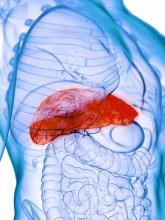New guidelines from the American College of Gastroenterology on idiosyncratic drug-induced liver injury (DILI) emphasize that idiosyncratic DILI is increasingly driven by the burgeoning popularity of herbal and dietary supplements, as well as tyrosine kinase inhibitors and immune checkpoint inhibitors used to treat cancer.
The guidelines, which represent an update from 2014, are published in The American Journal of Gastroenterology.
DILI is commonly seen by gastroenterologists and hepatologists, but it is challenging to diagnose because there are many potential causes, and no objective diagnostic tests. Its incidence in the general population is low, but it must be considered when facing unexplained liver injury. Its potential presence should also be considered when prescribing gastrointestinal medications like azathioprine, anti–tumor necrosis factor agents, and sulfonamides.
DILI can be characterized as intrinsic or idiosyncratic. Intrinsic DILI is somewhat predictable, based on human or animal studies that have revealed the potential for liver toxicity at higher doses. The best-known example is acetaminophen. Idiosyncratic DILI is rarer and shows up in individuals with a preexisting susceptibility. Clinical signs of idiosyncratic DILI are more diverse than intrinsic DILI. The ACG guideline focuses on idiosyncratic DILI, since guidelines are already available for intrinsic DILI.
Idiosyncratic DILI diagnosis can have a wide range of presentations, including asymptomatic liver biochemistry, jaundice, liver failure, and chronic hepatitis. Diagnosis is made by eliminating other potential causes.
In the presence of hepatocellular jaundice, mortality can reach 10%. DILI patients who develop progressive jaundice, regardless of concomitant coagulopathy, should be sent to a tertiary center and may be a candidate for liver transplantation.
Corticosteroids may be considered when there is uncertainty if a liver injury is from DILI or autoimmune hepatitis, but this remains controversial because some studies have shown benefit, while others have not, according to Bubu Banini, MD, PhD, assistant professor of medicine and research director of the metabolic health and weight management program at Yale University, New Haven, Conn. “Large-scale randomized controlled trials are needed for further elucidation of the role of steroids in DILI. For now, the guideline recommends consideration of steroid therapy, particularly in patients with features of autoimmune hepatitis,” she added.
An important factor driving DILI is the increasing popularity of herbal supplements, as well as increased use of some cancer therapies. “With the advent of immune checkpoint inhibitors as effective therapies for a variety of malignancies, physicians need to be aware of the potential side effects of these agents and the possibility of immune checkpoint inhibitor–related drug induced liver injury,” Dr. Banini said. The updated ACG guideline summarizes current FDA-approved immune checkpoint inhibitors and their potential to cause DILI. The drugs can also lead to reactivation of hepatitis B infection. Studies have shown liver enzyme elevation occurs in about 30% of patients treated with immune checkpoint inhibitors.
The guidelines recommend assessing DILI patients for hepatitis B and C, and treating patients prior to, or in combination with, immune checkpoint inhibitors or other chemotherapy drugs. The recommendations are in line with preliminary data from the ICI field, according to Dr. Banini.
Dr. Banini also noted there has been an increase in the use of herbal and dietary supplements in the United States over the past decade, and these now account for about one-fifth of DILI cases. The guidelines recommend that severe cholestatic disease from these agents should be managed similarly to cases caused by prescription drugs, and patients should be considered for liver transplant if necessary.
A web-based 6-month mortality calculator for suspected DILI is available. It uses Model for End-Stage Liver Disease, Charlson comorbidity Index, and serum albumin data. Those variables predict mortality in liver disease, and an independent analysis showed they predict 6-month mortality in DILI.
DILI is difficult to diagnose, but physicians should keep it in mind when faced with a case of liver enzyme abnormality, where other possibilities have been excluded. “With over a thousand medications potentially causing DILI, physicians should be familiar with LiverTox as a very useful and practical resource. The DILI mortality calculator can serve as a clinical tool to predict 6-month mortality in patients with suspected DILI,” Dr. Banini said.
Some authors disclosed relationships with several pharmaceutical companies. Dr. Banini reports having nothing to disclose.

